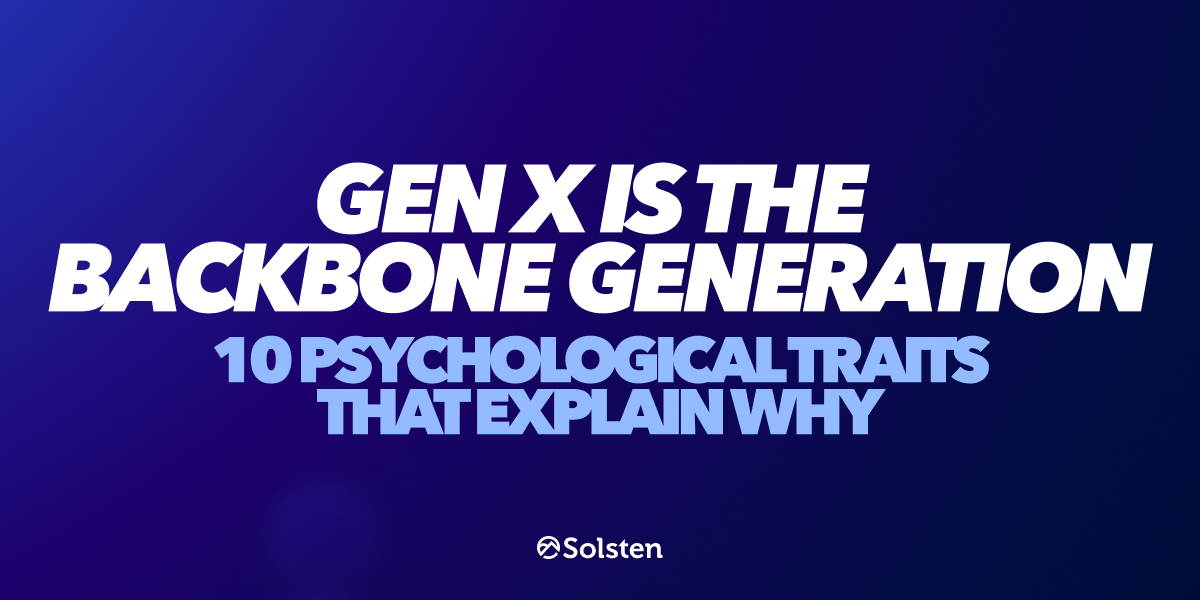Often overlooked in generational discussions, Generation X (born roughly between 1965 and 1980) has quietly become America’s backbone, steadily holding leadership positions across industries while bridging the often contentious divide between Baby Boomers and Millennials. Now aged approximately 44-59 in 2025, Gen X represents just 20% of the US adult population but holds a disproportionate 31% of leadership roles.
While media attention typically focuses on Baby Boomers’ retirement, Millennials‘ economic challenges, or Gen Z‘s digital fluency, our comprehensive psychological data reveals Gen X possesses a unique trait profile that makes them particularly suited for their stabilizing societal role.
New psychological data from Solsten’s ongoing assessment demonstrates that Gen X’s psychological makeup, which was shaped by their childhood experiences as “latchkey kids,” their adolescence during economic uncertainty, and their early adulthood during the dot-com boom and bust, has created a generation with a distinctive blend of independence, pragmatism, and adaptability.
Let’s look at the 10 key psychological traits that explain why Gen X has become America’s backbone generation.
The data in this article is drawn from Solsten’s ongoing psychological assessment, representing 3.4 billion people globally. Each trait is expressed as a percentile on a scale from 0-100, offering a quantitative insight into Millennial psychographics. You can learn more about Solsten’s methodology and data collection here.
Explore generational psychology insights like these instantly
The Gen X analysis you’re about to read demonstrates the power of psychological data. Now you can access these same insights through conversation with Elaris. Ask questions like “How does Gen X leadership style differ from Millennial leadership?” or “What psychological traits make Gen X effective managers?”
Elaris lets you discover insights from our 3.4 billion person database through simple conversation. Try it free.
Start exploring generational insights
1. Self-Control: Disciplined Decision-Making
Data Point: Gen X women score 49 and men score 46 on Self-Control — higher than almost every generation
Gen X scores higher on Self-Control than both Millennials and Gen Z, reflecting a greater capacity for disciplined decision-making and impulse management. This psychological trait measures the ability to regulate behavior and delay gratification.
This characteristic manifests in Gen X’s approach to career, finances, and life choices. While younger generations might pursue rapid job-hopping or gig work, Gen X typically builds longer tenures within organizations while still valuing flexibility. Their self-discipline enables them to balance competing priorities while maintaining focus on long-term goals.
The modest gender difference (women scoring three points higher) indicates that this trait is relatively consistent across Gen X, creating a generation known for reliability and steady performance rather than impulsive decisions.
2. Long-Term Orientation: Strategic Patience
Data Point: Gen X women score 52 and men score 50 on Long-Term Orientation — higher than every generation
Long-term orientation measures preference for delayed gratification and future planning over immediate rewards. Both Gen X genders outscore younger generations in this trait.
This strategic patience is apparent in Gen X’s financial approach, since they save at higher rates than Millennials despite facing many of the same economic pressures. It also explains their steady career progression, often choosing sustainable advancement over quick wins.
The gender difference (women scoring two points higher) suggests Gen X women may be particularly focused on long-range planning, potentially explaining their increasing representation in organizational leadership requiring strategic vision.
3. Competence: Confidence in Capability
Data Point: Gen X men and women both score 55 on Competence — highest of any generation
Gen X scores remarkably high on Competence, with both genders outscoring younger generations. This trait measures belief in one’s ability to effectively execute tasks and meet challenges.
This characteristic is clearly demonstrated in Gen X’s approach to leadership and problem-solving. They typically show less need for external validation than younger generations while maintaining more flexibility than older ones. Their competence also explains their comfort with both traditional and digital work environments, since they’ve mastered both.
The lack of score differential suggesting Gen X men and women share similar levels of capability confidence, unlike the more pronounced gender gaps in younger generations.
4. Stable-Mindedness: Emotional Resilience
Data Point: Gen X women score 51 and men score 55 on Stable-Mindedness — higher than younger generations
Gen X scores significantly higher on Stable-Mindedness than younger generations, particularly among men. This trait measures emotional resilience and ability to maintain equilibrium under pressure.
This stable-mindedness manifests in Gen X’s crisis management abilities. They typically remain calmer during workplace challenges and adapt to changing priorities with less emotional turbulence than other generations. This trait has positioned them as stabilizing forces in organizations navigating uncertainty.
The gender difference (men scoring four points higher) suggests Gen X men may have particularly developed emotional resilience, potentially contributing to their steady career progression despite economic volatility.
5. Independence: Self-Reliant Problem-Solving
Data Point: Gen X women score 55 and men score 57 on Independence
Gen X scores exceptionally high on Independence, with both genders showing strong self-reliance. This trait measures preference for autonomous decision-making and self-directed action.
Gen X’s approach to work and leadership is helped by this independence. They require less oversight than younger colleagues while demonstrating greater comfort with autonomous problem-solving. Their independence also explains their entrepreneurial tendencies, since Gen X starts more businesses per capita than other generations.
The modest gender difference (men scoring two points higher) indicates that independence is a defining trait across the generation, creating a cohort comfortable taking initiative without constant direction.
6. Trust: Balanced Skepticism
Data Point: Gen X women score 58 and men score 53 on Trust — higher than younger generations
We can see an interesting Gen X pattern on Trust – higher than younger generations but lower than Baby Boomers, with a notable gender difference. This trait measures belief in others’ goodwill and reliability.
This characteristic shows up in Gen X’s approach to information and authority. They typically verify before trusting while remaining open to evidence, creating a healthy skepticism rather than either naive acceptance or entrenched cynicism. This balanced perspective makes them effective mediators between more trusting Baby Boomers and more skeptical Millennials.
The substantial gender difference (women scoring five points higher) suggests Gen X women may be more inclined toward institutional engagement, potentially explaining their increasing leadership in traditional organizations.
7. Fearlessness: Comfort with Risk
Data Point: Gen X women score 54 and men score 58 on Fearlessness — higher than younger generations
Gen X scores remarkably high on Fearlessness, particularly among men. This trait measures comfort with risk-taking and new challenges.
Gen X’s fearlessness is obvious in their career approaches. They typically demonstrate greater comfort with change and uncertainty than Baby Boomers while maintaining more caution than Millennials. Their fearlessness also explains their pioneering role in early internet companies and their continued leadership in innovation sectors.
The gender difference (men scoring four points higher) suggests Gen X men may be particularly comfortable with professional risks, potentially contributing to their strong representation in entrepreneurial ventures.
8. Persistence: Determined Goal Pursuit
Data Point: Gen X women score 53 and men score 49 on Persistence — higher than every generation
Gen X shows strong Persistence scores, particularly among women. This trait measures determination in pursuing goals despite obstacles or setbacks.
Persistence is a major player in Gen X’s career longevity and resilience. They typically demonstrate greater tenacity in pursuing long-term goals than younger generations while showing more adaptability in their methods than older ones. Their persistence explains their steady rise to leadership positions despite navigating multiple recessions and workplace transformations.
The substantial gender difference (women scoring four points higher) suggests Gen X women may be particularly determined in overcoming obstacles, potentially explaining their breakthroughs in historically male-dominated fields.
9. Empathy: Understanding Others’ Emotions
Data Point: Gen X women score 54 and men score 42 on Empathy — higher than younger generations
Gen X shows a significant gender difference in Empathy, with women scoring particularly high while men fall in the moderate range. This trait measures ability to understand and share others’ emotional states.
Gen X’s empathy pattern is evident in their leadership styles. Gen X women typically demonstrate stronger people-focused leadership approaches, while Gen X men often combine traditional task-orientation with greater emotional awareness than previous generations. This combination has made Gen X effective bridge-builders between different workplace cultures.
The substantial gender gap (women scoring 12 points higher) represents one of the largest psychological differences within Gen X, suggesting distinct leadership advantages for each gender.
10. Ambition: Achievement Drive
Data Point: Gen X women and men both score score 51 on Ambition — higher than every generation
Gen X shows strong and remarkably balanced Ambition scores across genders. This trait measures drive toward achievement and success.
This balanced ambition characteristic is most obvious in Gen X’s career approach. They typically maintain strong achievement orientation without the workaholic tendencies of some Baby Boomers or the work-life integration focus of many Millennials. Their ambition also explains their consistent upward mobility despite entering the workforce during periods of economic uncertainty.
The lack of gender difference is particularly notable, suggesting that Gen X men and women share nearly identical achievement drives, unlike the more pronounced gaps in other generations.
The Psychological Profile of Gen X
As Gen X navigates their 40s and 50s, their unique psychological profile has positioned them as America’s backbone generation, providing stability and leadership during a period of rapid change and generational tension.
Their high Self-Control and Long-Term Orientation characteristics create steady decision-making. Their strong Competence and Stable-Mindedness enable resilient leadership. Their Independence and balanced Trust foster pragmatic problem-solving. Their Fearlessness and Persistence drive innovation with tenacity. And their combination of Empathy and Ambition creates leadership that balances people and results.
This psychological profile explains why Gen X has quietly assumed leadership across sectors while receiving less attention than other generations. They aren’t defined by dramatic psychological extremes but rather by a balanced, adaptive trait profile that makes them particularly suited for bridging divides and maintaining stability amid change.
As workplace demographics continue shifting, understanding Gen X’s psychological makeup becomes increasingly important. They aren’t merely a small generation sandwiched between Baby Boomers and Millennials, but are a psychologically distinct cohort whose traits have made them the essential backbone holding together America’s institutions during a period of unprecedented transformation.
Want dive into your customers’ psychology? Check out our step-by-step tutorial and start turning insights into action today.
From demographic assumptions to psychological understanding
Traditional demographic data tells you Gen X is 44-59 years old. Psychological data reveals they’re independent, persistent, and competent leaders. This depth of understanding transforms how you market to, manage, and develop products for any generation.
Start free and discover what psychological insights reveal about your target demographics.
Get psychological insights now





